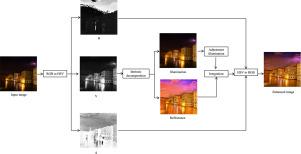基于联合引导全变分的微光图像增强方法
IF 3.6
2区 工程技术
Q2 ENGINEERING, ELECTRICAL & ELECTRONIC
引用次数: 0
摘要
弱光图像增强对于高质量图像显示和各种视觉应用至关重要。然而,在增强图像亮度的同时保持图像的视觉自然性是一项具有挑战性的任务。提出了一种综合引导总变差和亮度自适应校正的弱光图像增强算法。为了获得结构清晰、细节纹理光滑的照明图像,采用引入导光滤波器的窗口的总变分作为照明规则项。采用对数平均局部方差作为反射正则化项,提取更能反映图像的纹理细节。此外,为了解决极低照度区域的颜色失真问题,采用弧切变换来增强极低照度区域的颜色和对比度。我们使用交替优化算法求解该模型。在模型中,每个子问题都被转化为一个矢量化的最小二乘回归,具有封闭形式的解。在几个公开数据集上的实验结果表明,我们的方法在保持颜色对比度和细节信息的同时很好地抑制了噪声。与其他先进的算法相比,所提出的模型在主观和客观评价方面都有更好的结果。本文章由计算机程序翻译,如有差异,请以英文原文为准。

Low-light image enhancement method based on joint guiding total variation
Low-light image enhancement is crucial for high-quality image display and various visual applications. However, maintaining the visual naturalness of an image while enhancing its brightness presents a challenging task. We propose a novel algorithm for low-light image enhancement that joint guiding total variation and luminance adaptive correction. In order to obtain illuminated images with clear structure and smooth detail texture, the total variation of the window incorporating the guiding filter is used as the illumination regularity term. Logarithmic mean local variance is used as a reflection regularization term to extract texture details better reflecting the image. In addition, to address the issue of color distortion in areas with extremely low illumination, an arc-tangent transform is used to enhance the color and contrast in the very low-light region. We solve the model using an alternating optimization algorithm. In the model, each sub-problem is transformed into a vectorized least squares regression, with closed-form solutions. Experimental results on several public datasets demonstrate that our method suppresses the noise well while maintaining the color contrast and detail information. In comparison to other advanced algorithms, the proposed model delivers superior results in both subjective and objective evaluations.
求助全文
通过发布文献求助,成功后即可免费获取论文全文。
去求助
来源期刊

Signal Processing
工程技术-工程:电子与电气
CiteScore
9.20
自引率
9.10%
发文量
309
审稿时长
41 days
期刊介绍:
Signal Processing incorporates all aspects of the theory and practice of signal processing. It features original research work, tutorial and review articles, and accounts of practical developments. It is intended for a rapid dissemination of knowledge and experience to engineers and scientists working in the research, development or practical application of signal processing.
Subject areas covered by the journal include: Signal Theory; Stochastic Processes; Detection and Estimation; Spectral Analysis; Filtering; Signal Processing Systems; Software Developments; Image Processing; Pattern Recognition; Optical Signal Processing; Digital Signal Processing; Multi-dimensional Signal Processing; Communication Signal Processing; Biomedical Signal Processing; Geophysical and Astrophysical Signal Processing; Earth Resources Signal Processing; Acoustic and Vibration Signal Processing; Data Processing; Remote Sensing; Signal Processing Technology; Radar Signal Processing; Sonar Signal Processing; Industrial Applications; New Applications.
 求助内容:
求助内容: 应助结果提醒方式:
应助结果提醒方式:


